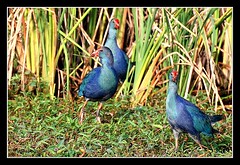The Purple Swamphen (Porphyrio porphyrio), also known as the African Purple Swamphen or Purple Moorhen or Purple Gallinule or Purple Coot , is a large bird in the family Rallidae. From its name in French, talève sultane, it is also sometimes known as the Sultana Bird.
Purple Swamphens are considered to be the ancestors of several island species including the extinct Lord Howe Swamphen and two species of Takahē in New Zealand. The Purple Swamphen itself, deriving from a later self-introduction, is a native of New Zealand, where it is called the Pūkeko. Its range is thought to have expanded there after the arrival of humans as the numbers of Takahē declined to near-extinction levels.
The Purple Swamphen prefers wet areas with high rainfall, swamps, lake edges and damp pastures. The birds often live in pairs and larger communities. It clambers through the reeds, eating the tender shoots and vegetable-like matter, they have been known to feed on invertebrates (like snails) and to rob eggs from nests and also eat ducklings. Sometimes they eat small fishes as well. They will often use one foot to bring food to their mouth rather than eat it on the ground. Where they are not persecuted they can become tame and be readily seen in towns and cities.
This species has a very loud explosive call, also described as a "raucous high-pitched screech, with a subdued musical tuk-tuk". It is particularly noisy during the breeding season. In spite of being clumsy in flight it can fly long distances, and it is also a good swimmer, especially for a bird without webbed feet.
The breeding habitat is warm reed beds across southernmost Europe, Africa, tropical Asia, and Australasia. The male has an elaborate courtship display,holding water weeds in his bill and bowing to the female with loud chuckles.[1]
Pairs nest in a large pad of interwoven reed flags, etc., on a mass of floating debris or amongst matted reeds slightly above water level in swamps, clumps of rushes in paddocks or long unkempt grass. Multiple females lay in the one nest and share the incubation duties, the nest is composed of grass or similar materials. Each bird can lay 3-6 speckled eggs - pale yellowish stone to reddish buff, blotched and spotted with reddish brown. A communal nest may contain up to 12 eggs, incubation period is 24 days.



No comments:
Post a Comment